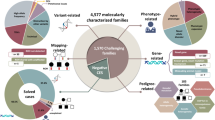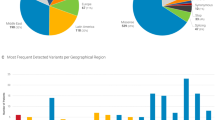Abstract
Niemann–Pick disease type B (NPDB) is a rare, inherited lysosomal storage disorder that occurs due to variants in the sphingomyelin phosphodiesterase 1 (SMPD1) gene and the resultant deficiency of acid sphingomyelinase (ASM) activity. While numerous variants causing NPDB have been described, only a small number have been studied in any detail. Herein, we describe the frequency of the p.(Ala359Asp) variant in the healthy Chilean population, and determine the haplotype background of homozygous patients to establish if this variant originated from a common founder. Genomic DNA samples from 1691 healthy individuals were analyzed for the p.(Ala359Asp) variant. The frequency of p.(Ala359Asp) was found to be 1/105.7, predicting a disease incidence of 1/44 960 in Chile, higher than the incidence estimated by the number of confirmed NPDB cases. We also describe the clinical characteristics of 13 patients homozygous for p.(Ala359Asp) and all of them had moderate to severe NPDB disease. In addition, a conserved haplotype and shared 280 Kb region around the SMPD1 gene was observed in the patients analyzed, indicating that the variant originated from a common ancestor. The haplotype frequency and mitochondrial DNA analysis suggest an Amerindian origin for the variant. To assess the effect of the p.(Ala359Asp) variant, we transfected cells with the ASM-p.(Ala359Asp) cDNA and the activity was only 4.2% compared with the wild-type cDNA, definitively demonstrating the causative effect of the variant on ASM function. Information on common variants such as p.(Ala359Asp) is essential to guide the successful implementation for future therapies and benefit to patients.
Similar content being viewed by others
Log in or create a free account to read this content
Gain free access to this article, as well as selected content from this journal and more on nature.com
or
References
Schuchman EH, Levran O, Pereira LV, Desnick RJ : Structural organization and complete nucleotide sequence of the gene encoding human acid sphingomyelinase (SMPD1). Genomics 1992; 12: 197–205.
Schuchman EH : The pathogenesis and treatment of acid sphingomyelinase-deficient Niemann-Pick disease. J Inherit Metab Dis 2007; 30: 654–663.
Schuchman EH, Desnick RJ : Niemann-pick disease types A and B: acid sphingomyelinase deficiencies; in Valle D (ed): The Online Metabolic and Molecular Bases of Inherited Disease, Online edn New York, NY, USA: McGraw-Hill Companies, Inc. p 144.
Smith EL, Schuchman EH : The unexpected role of acid sphingomyelinase in cell death and the pathophysiology of common diseases. FASEB J 2008; 22: 3419–3431.
Wasserstein MP, Desnick RJ, Schuchman EH et al: The natural history of type B Niemann-Pick disease: results from a 10-year longitudinal study. Pediatrics 2004; 114: e672–e677.
Wasserstein MP, Aron A, Brodie SE, Simonaro C, Desnick RJ, McGovern MM : Acid sphingomyelinase deficiency: prevalence and characterization of an intermediate phenotype of Niemann-Pick disease. J Pediatr 2006; 149: 554–559.
Pavlu-Pereira H, Asfaw B, Poupctova H et al: Acid sphingomyelinase deficiency. Phenotype variability with prevalence of intermediate phenotype in a series of twenty-five Czech and Slovak patients. A multi-approach study. J Inherit Metab Dis 2005; 28: 203–227.
Simonaro CM, Desnick RJ, McGovern MM, Wasserstein MP, Schuchman EH : The demographics and distribution of type B Niemann-Pick disease: novel mutations lead to new genotype/phenotype correlations. Am J Hum Genet 2002; 71: 1413–1419.
McGovern MM, Lippa N, Bagiella E, Schuchman EH, Desnick RJ, Wasserstein MP : Morbidity and mortality in type B Niemann-Pick disease. Genet Med 2013; 15: 618–623.
Desnick RJ, Schuchman EH : Enzyme replacement therapy for lysosomal diseases: lessons from 20 years of experience and remaining challenges. Ann Rev Genom Hum Genet 2012; 13: 307–335.
Platt FM, Lachmann RH : Treating lysosomal storage disorders: current practice and future prospects. Biochim Biophy Acta 2009; 1793: 737–745.
Schuchman EH, Simonaro CM : The genetics of sphingolipid hydrolases and sphingolipid storage diseases. Handb Exp Pharmacol 2013; 215: 3–32.
Desnick JP, Kim J, He X, Wasserstein MP, Simonaro CM, Schuchman EH : Identification and characterization of eight novel SMPD1 mutations causing types A and B Niemann-Pick disease. Mol Med 2010; 16: 316–321.
Mihaylova V, Hantke J, Sinigerska I et al: Highly variable neural involvement in sphingomyelinase-deficient Niemann-Pick disease caused by an ancestral Gypsy mutation. Brain 2007; 130: 1050–1061.
Jones I, He X, Katouzian F, Darroch PI, Schuchman EH : Characterization of common SMPD1 mutations causing types A and B Niemann-Pick disease and generation of mutation-specific mouse models. Mol Genet Metab 2008; 95: 152–162.
de Saint Pierre M, Bravi CM, Motti JM et al: An alternative model for the early peopling of southern South America revealed by analyses of three mitochondrial DNA haplogroups. PloS One 2012; 7: e43486.
Li H, Durbin R : Fast and accurate long-read alignment with Burrows-Wheeler transform. Bioinformatics 2010; 26: 589–595.
Li H, Handsaker B, Wysoker A et al: The sequence alignment/map format and SAMtools. Bioinformatics 2009; 25: 2078–2079.
He X, Chen F, Dagan A, Gatt S, Schuchman EH : A fluorescence-based, high-performance liquid chromatographic assay to determine acid sphingomyelinase activity and diagnose types A and B Niemann-Pick disease. Anal Biochem 2003; 314: 116–120.
Miquel JF, Covarrubias C, Villaroel L et al: Genetic epidemiology of cholesterol cholelithiasis among Chilean Hispanics, Amerindians, and Maoris. Gastroenterology 1998; 115: 937–946.
Hakonen AH, Davidzon G, Salemi R et al: Abundance of the POLG disease mutations in Europe, Australia, New Zealand, and the United States explained by single ancient European founders. Eur J Hum Genet 2007; 15: 779–783.
Moraga ML, Rocco P, Miquel JF et al: Mitochondrial DNA polymorphisms in Chilean aboriginal populations: implications for the peopling of the southern cone of the continent. Am J Phys Anthropol 2000; 113: 19–29.
Bodner M, Perego UA, Huber G et al: Rapid coastal spread of First Americans: novel insights from South America's Southern Cone mitochondrial genomes. Genome Res 2012; 22: 811–820.
de Saint Pierre M, Gandini F, Perego UA et al: Arrival of Paleo-Indians to the southern cone of South America: new clues from mitogenomes. PloS One 2012; 7: e51311.
Vanier MT, Ferlinz K, Rousson R et al: Deletion of arginine (608) in acid sphingomyelinase is the prevalent mutation among Niemann-Pick disease type B patients from northern Africa. Hum Genet 1993; 92: 325–330.
Reich D, Patterson N, Campbell D et al: Reconstructing Native American population history. Nature 2012; 488: 370–374.
Seto M, Whitlow M, McCarrick MA et al: A model of the acid sphingomyelinase phosphoesterase domain based on its remote structural homolog purple acid phosphatase. Protein Sci 2004; 13: 3172–3186.
Acknowledgements
We thank Fermin Robledo for excellent technical support. We also acknowledge the Humboldt Foundation (Germany) for donating the ABI 7500 sequence detection system. This work was supported by grants from the Fondo Nacional de Desarrollo Científico y Tecnológico (FONDECYT; grant numbers 1110310 and 1150186) to SZ and (grant number 1130303) to JFM; Fondo Nacional de Desarrollo de Areas Prioritarias, FONDAP Center for Genome Regulation (CGR; Project number 15090007) to SZ, JFM, MG and RAG; Genzyme grant ‘Assessment of the p.(Ala359Asp) acid sphingomyelinase gene variant frequency in the Chilean population’ to PM, EHS, SZ; Comisión Nacional de Ciencia y Tecnología (CONICYT) PhD student (grant number 21120490) to MA; National Institutes of Health grant HD28607 to EHS.
Author information
Authors and Affiliations
Corresponding authors
Ethics declarations
Competing interests
EHS is an inventor on several patents licensed to Genzyme, a Sanofi Corporation, that describes the diagnosis and treatment of NPD. P Mabe has received a speaker honorarium form Genzyme, a Sanofi Corporation, and BioMarin. Also she has received support for assistance to scientific meetings from Genzyme, BioMarin and Shire. P Mabe and SZ have received research grants from Genzyme, a Sanofi Corporation. The remaining authors declare no conflict of interest.
Additional information
Supplementary Information accompanies this paper on European Journal of Human Genetics website
Supplementary information
Rights and permissions
About this article
Cite this article
Acuña, M., Martínez, P., Moraga, C. et al. Epidemiological, clinical and biochemical characterization of the p.(Ala359Asp) SMPD1 variant causing Niemann–Pick disease type B. Eur J Hum Genet 24, 208–213 (2016). https://doi.org/10.1038/ejhg.2015.89
Received:
Revised:
Accepted:
Published:
Issue date:
DOI: https://doi.org/10.1038/ejhg.2015.89
This article is cited by
-
Assessment of health state utilities associated with adult and pediatric acid sphingomyelinase deficiency (ASMD)
The European Journal of Health Economics (2024)
-
Consensus clinical management guidelines for acid sphingomyelinase deficiency (Niemann–Pick disease types A, B and A/B)
Orphanet Journal of Rare Diseases (2023)
-
Chronic visceral acid sphingomyelinase deficiency (Niemann-Pick disease type B) in 16 Polish patients: long-term follow-up
Orphanet Journal of Rare Diseases (2019)
-
Disease manifestations and burden of illness in patients with acid sphingomyelinase deficiency (ASMD)
Orphanet Journal of Rare Diseases (2017)



